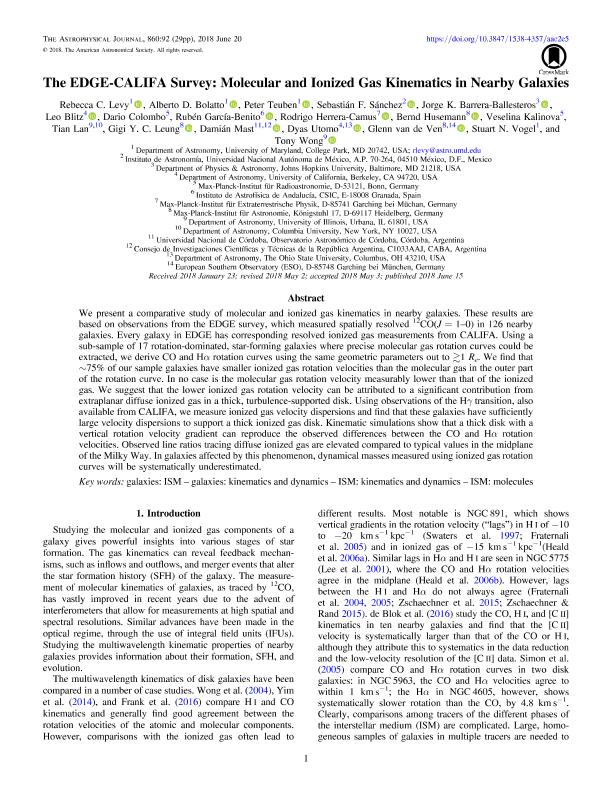Mostrar el registro sencillo del ítem
dc.contributor.author
Levy, Rebecca C.
dc.contributor.author
Bolatto, Alberto

dc.contributor.author
Teuben, Peter
dc.contributor.author
Sánchez, Sebastián F.
dc.contributor.author
Barrera Ballesteros, Jorge K.

dc.contributor.author
Blitz, Leo
dc.contributor.author
Colombo, Dario
dc.contributor.author
García Benito, Rubén

dc.contributor.author
Herrera Camus, Rodrigo
dc.contributor.author
Husemann, Bernd

dc.contributor.author
Kalinova, Veselina
dc.contributor.author
Lan, Tian
dc.contributor.author
Leung, Gigi Y. C.
dc.contributor.author
Mast, Damian

dc.contributor.author
Utomo, Dyas
dc.contributor.author
Ven, Glenn van de
dc.contributor.author
Vogel, Stuart N.
dc.contributor.author
Wong, Tony
dc.date.available
2022-08-05T17:38:23Z
dc.date.issued
2018-06
dc.identifier.citation
Levy, Rebecca C.; Bolatto, Alberto; Teuben, Peter; Sánchez, Sebastián F.; Barrera Ballesteros, Jorge K.; et al.; The EDGE-CALIFA Survey: Molecular and Ionized Gas Kinematics in Nearby Galaxies; IOP Publishing; Astrophysical Journal; 860; 2; 6-2018; 1-29
dc.identifier.issn
0004-637X
dc.identifier.uri
http://hdl.handle.net/11336/164413
dc.description.abstract
We present a comparative study of molecular and ionized gas kinematics in nearby galaxies. These results are based on observations from the EDGE survey, which measured spatially resolved 12CO(J = 1-0) in 126 nearby galaxies. Every galaxy in EDGE has corresponding resolved ionized gas measurements from CALIFA. Using a sub-sample of 17 rotation-dominated, star-forming galaxies where precise molecular gas rotation curves could be extracted, we derive CO and Hα rotation curves using the same geometric parameters out to 1 R e. We find that ∼75% of our sample galaxies have smaller ionized gas rotation velocities than the molecular gas in the outer part of the rotation curve. In no case is the molecular gas rotation velocity measurably lower than that of the ionized gas. We suggest that the lower ionized gas rotation velocity can be attributed to a significant contribution from extraplanar diffuse ionized gas in a thick, turbulence-supported disk. Using observations of the Hγ transition, also available from CALIFA, we measure ionized gas velocity dispersions and find that these galaxies have sufficiently large velocity dispersions to support a thick ionized gas disk. Kinematic simulations show that a thick disk with a vertical rotation velocity gradient can reproduce the observed differences between the CO and Hα rotation velocities. Observed line ratios tracing diffuse ionized gas are elevated compared to typical values in the midplane of the Milky Way. In galaxies affected by this phenomenon, dynamical masses measured using ionized gas rotation curves will be systematically underestimated.
dc.format
application/pdf
dc.language.iso
eng
dc.publisher
IOP Publishing

dc.rights
info:eu-repo/semantics/openAccess
dc.rights.uri
https://creativecommons.org/licenses/by-nc-sa/2.5/ar/
dc.subject
GALAXIES: ISM
dc.subject
GALAXIES: KINEMATICS AND DYNAMICS
dc.subject
ISM: KINEMATICS AND DYNAMICS
dc.subject
ISM: MOLECULES
dc.subject.classification
Astronomía

dc.subject.classification
Ciencias Físicas

dc.subject.classification
CIENCIAS NATURALES Y EXACTAS

dc.title
The EDGE-CALIFA Survey: Molecular and Ionized Gas Kinematics in Nearby Galaxies
dc.type
info:eu-repo/semantics/article
dc.type
info:ar-repo/semantics/artículo
dc.type
info:eu-repo/semantics/publishedVersion
dc.date.updated
2022-08-03T18:19:24Z
dc.identifier.eissn
1538-4357
dc.journal.volume
860
dc.journal.number
2
dc.journal.pagination
1-29
dc.journal.pais
Reino Unido

dc.journal.ciudad
Londres
dc.description.fil
Fil: Levy, Rebecca C.. University of Maryland; Estados Unidos
dc.description.fil
Fil: Bolatto, Alberto. University of Maryland; Estados Unidos
dc.description.fil
Fil: Teuben, Peter. University of Maryland; Estados Unidos
dc.description.fil
Fil: Sánchez, Sebastián F.. Universidad Nacional Autónoma de México; México
dc.description.fil
Fil: Barrera Ballesteros, Jorge K.. University Johns Hopkins; Estados Unidos
dc.description.fil
Fil: Blitz, Leo. University of California at Berkeley; Estados Unidos
dc.description.fil
Fil: Colombo, Dario. Max Planck Institut Fur Radioastronomie; Alemania
dc.description.fil
Fil: García Benito, Rubén. Consejo Superior de Investigaciones Científicas; España
dc.description.fil
Fil: Herrera Camus, Rodrigo. Institut Max Planck fuer Gesellschaft. Max Planck Institute for Extraterrestrial Physics; Alemania
dc.description.fil
Fil: Husemann, Bernd. Max Planck Institut Fur Astronomie; Alemania
dc.description.fil
Fil: Kalinova, Veselina. Max Planck Institut Fur Radioastronomie; Alemania
dc.description.fil
Fil: Lan, Tian. University of Illinois; Estados Unidos. Columbia University; Estados Unidos
dc.description.fil
Fil: Leung, Gigi Y. C.. Max Planck Institut Fur Astronomie; Alemania
dc.description.fil
Fil: Mast, Damian. Consejo Nacional de Investigaciones Científicas y Técnicas. Centro Científico Tecnológico Conicet - Córdoba; Argentina. Universidad Nacional de Córdoba. Observatorio Astronómico de Córdoba; Argentina
dc.description.fil
Fil: Utomo, Dyas. Ohio State University; Estados Unidos. University of California at Berkeley; Estados Unidos
dc.description.fil
Fil: Ven, Glenn van de. European Southern Observatory; Alemania. Max Planck Institut Fur Astronomie; Alemania
dc.description.fil
Fil: Vogel, Stuart N.. University of Maryland; Estados Unidos
dc.description.fil
Fil: Wong, Tony. University of Illinois; Estados Unidos
dc.journal.title
Astrophysical Journal

dc.relation.alternativeid
info:eu-repo/semantics/altIdentifier/doi/http://dx.doi.org/10.3847/1538-4357/aac2e5
dc.relation.alternativeid
info:eu-repo/semantics/altIdentifier/url/https://iopscience.iop.org/article/10.3847/1538-4357/aac2e5
Archivos asociados
